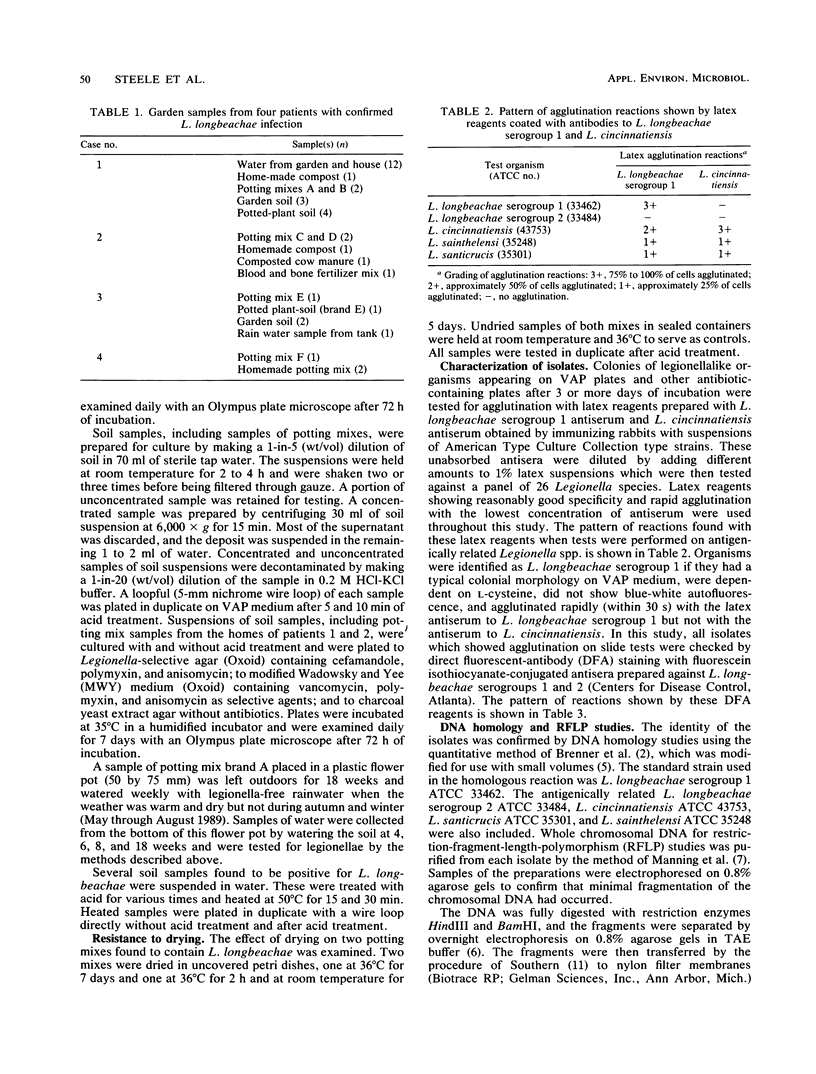Abstract
Following a statewide outbreak of legionellosis due to Legionella longbeachae serogroup 1 in South Australia in 1988 and 1989, studies were performed to find a source of the organism. A number of water and soil samples with and without acid decontamination were examined for L. longbeachae by using a selective medium containing vancomycin, aztreonam, and pimafucin. There were no isolations of L. longbeachae from water samples. Organisms resembling L. longbeachae were isolated from a number of samples of potting mixes and from soil surrounding plants in pots collected from the homes of four patients. The organisms were found to persist for 7 months in two potting mixes stored at room temperature. Legionellae were isolated with difficulty from potting mixes which were allowed to dry out. Identification of isolates as L. longbeachae serogroup 1 was confirmed by quantitative DNA hybridization and serological tests. Restriction-fragment-length-polymorphism studies showed minor differences between patient and environmental isolates but differentiated these readily from L. longbeachae serogroup 2 and other antigenically related legionellae. The isolation of L. longbeachae from some potting mixes and the prolonged survival of the organisms in this medium suggest that soil rather than water is the natural habitat of this species and may be the source of human infections.
Full text
PDF




Images in this article
Selected References
These references are in PubMed. This may not be the complete list of references from this article.
- Bibb W. F., Sorg R. J., Thomason B. M., Hicklin M. D., Steigerwalt A. G., Brenner D. J., Wulf M. R. Recognition of a second serogroup of Legionella longbeachae. J Clin Microbiol. 1981 Dec;14(6):674–677. doi: 10.1128/jcm.14.6.674-677.1981. [DOI] [PMC free article] [PubMed] [Google Scholar]
- Brenner D. J., Fanning G. R., Rake A. V., Johnson K. E. Batch procedure for thermal elution of DNA from hydroxyapatite. Anal Biochem. 1969 Apr 4;28(1):447–459. doi: 10.1016/0003-2697(69)90199-7. [DOI] [PubMed] [Google Scholar]
- Desplaces N., Nahapetian N., Bure A., Dournon E. Legionella longbeachae serogroup 2 in Europe. Lancet. 1982 Dec 18;2(8312):1400–1400. doi: 10.1016/s0140-6736(82)91298-3. [DOI] [PubMed] [Google Scholar]
- Lambert M. A., Moss C. W. Cellular fatty acid compositions and isoprenoid quinone contents of 23 Legionella species. J Clin Microbiol. 1989 Mar;27(3):465–473. doi: 10.1128/jcm.27.3.465-473.1989. [DOI] [PMC free article] [PubMed] [Google Scholar]
- Lim I., Sangster N., Reid D. P., Lanser J. A. Legionella longbeachae pneumonia: report of two cases. Med J Aust. 1989 May 15;150(10):599–601. doi: 10.5694/j.1326-5377.1989.tb136700.x. [DOI] [PubMed] [Google Scholar]
- Manning P. A., Heuzenroeder M. W., Yeadon J., Leavesley D. I., Reeves P. R., Rowley D. Molecular cloning and expression in Escherichia coli K-12 of the O antigens of the Inaba and Ogawa serotypes of the Vibrio cholerae O1 lipopolysaccharides and their potential for vaccine development. Infect Immun. 1986 Aug;53(2):272–277. doi: 10.1128/iai.53.2.272-277.1986. [DOI] [PMC free article] [PubMed] [Google Scholar]
- McKinney R. M., Porschen R. K., Edelstein P. H., Bissett M. L., Harris P. P., Bondell S. P., Steigerwalt A. G., Weaver R. E., Ein M. E., Lindquist D. S. Legionella longbeachae species nova, another etiologic agent of human pneumonia. Ann Intern Med. 1981 Jun;94(6):739–743. doi: 10.7326/0003-4819-94-6-739. [DOI] [PubMed] [Google Scholar]
- Ortiz-Roque C. M., Hazen T. C. Abundance and distribution of Legionellaceae in Puerto Rican waters. Appl Environ Microbiol. 1987 Sep;53(9):2231–2236. doi: 10.1128/aem.53.9.2231-2236.1987. [DOI] [PMC free article] [PubMed] [Google Scholar]
- Schlech W. F., 3rd, Gorman G. W., Payne M. C., Broome C. V. Legionnaires' disease in the Caribbean. An outbreak associated with a resort hotel. Arch Intern Med. 1985 Nov;145(11):2076–2079. [PubMed] [Google Scholar]
- Southern E. M. Detection of specific sequences among DNA fragments separated by gel electrophoresis. J Mol Biol. 1975 Nov 5;98(3):503–517. doi: 10.1016/s0022-2836(75)80083-0. [DOI] [PubMed] [Google Scholar]
- Thacker W. L., Benson R. F., Staneck J. L., Vincent S. R., Mayberry W. R., Brenner D. J., Wilkinson H. W. Legionella cincinnatiensis sp. nov. isolated from a patient with pneumonia. J Clin Microbiol. 1988 Mar;26(3):418–420. doi: 10.1128/jcm.26.3.418-420.1988. [DOI] [PMC free article] [PubMed] [Google Scholar]
- Thacker W. L., Plikaytis B. B., Wilkinson H. W. Identification of 22 Legionella species and 33 serogroups with the slide agglutination test. J Clin Microbiol. 1985 May;21(5):779–782. doi: 10.1128/jcm.21.5.779-782.1985. [DOI] [PMC free article] [PubMed] [Google Scholar]



